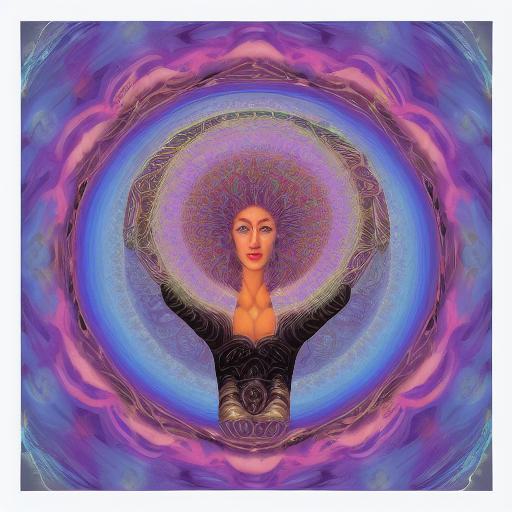How to write this prompt?
How each individual part can influence the image being generated:
- Theme: The theme of the image is a digital psychedelic painting inspired by Amanda Sage, Artstation contest winner. This sets the overall style and mood for the image.
- Subject: The subject of the image is a woman with a laughing flower in her hand. This gives a clear focal point to the image and provides a visual narrative for the viewer.
- Colors: The colors of the image are predominantly blue and purple with some white and gray accents. This sets the tone for the image and creates a specific color palette that the AI can use when generating the image.
- Camera angle: The camera angle is a low angle view, giving a massive scale and grandeur to the image. This creates a sense of awe and wonder for the viewer and can be used to make the subject of the image appear larger than life.
- Lighting: The lighting is a mixture of natural and overglaze lighting, giving an ethereal and mystical feel to the image. This creates a dream-like atmosphere and adds to the psychedelic feel of the image.
Each of these individual parts of the prompt can influence the image being generated by the AI. For example, the colors used in the image can create a specific mood or emotion, while the camera angle and lighting can be used to create a sense of scale and depth. By combining these different elements in a cohesive way, the AI can generate an image that captures the essence of the prompt and brings the vision to life.
What is the importance of color in digital art?
Color is an important element in digital art as it can set the tone and mood of the artwork, convey emotion, and create visual interest. Colors can be used to draw attention to specific areas of the image, create contrast, and add depth and dimension to the artwork.
How to create a psychedelic effect in digital art?
To create a psychedelic effect in digital art, one can use a combination of bright and bold colors, organic shapes and patterns, and distorted imagery. Experimenting with different blending modes, filters, and layer styles can also help to create a psychedelic look and feel.
Why is lighting important in digital art?
Lighting is important in digital art as it can add depth and dimension to the artwork, create a sense of mood and atmosphere, and help to direct the viewer’s attention to specific areas of the image. By using different lighting techniques, such as natural or artificial lighting, and experimenting with shadows and highlights, artists can create a more realistic and immersive experience for the viewer.
What is the future of AI art generation?
The future of AI art generation is promising and exciting. As AI technology continues to advance, we can expect to see more sophisticated and realistic AI-generated art. AI algorithms are becoming better at recognizing patterns, textures, and shapes, which can lead to more complex and visually stunning artwork. Furthermore, AI art generation has the potential to democratize the art world by making it more accessible and inclusive to people who may not have traditional art skills or training.
One exciting development in AI art generation is the use of generative adversarial networks (GANs), which can create highly realistic images by training two neural networks to compete against each other. GANs have been used to create everything from realistic portraits to entire cityscapes, and the results are often stunningly realistic.
Another trend in AI art generation is the use of machine learning algorithms to analyze and interpret data, such as sound or motion, and use that data to create artwork. This has led to the development of interactive and dynamic art installations that respond to the environment around them.
Can AI-generated art be improved or edited by humans?
Yes, AI-generated art can be improved or edited by humans. While AI algorithms are becoming better at generating realistic and visually appealing art, they are not yet capable of fully replacing the creative process of human artists. Therefore, human intervention is often needed to refine and improve the output of AI-generated art.
One common way that humans can improve AI-generated art is by using post-processing techniques, such as adjusting color levels or adding texture. This can help to enhance the overall quality of the artwork and give it a more personalized touch. Additionally, humans can also provide feedback to the AI algorithms to help improve their performance and accuracy.
Another way that humans can edit AI-generated art is by using it as a starting point for their own creative process. For example, an artist may use an AI-generated landscape as the basis for a painting or use AI-generated shapes as inspiration for a sculpture. By combining the strengths of AI and human creativity, we can create truly unique and innovative artwork that pushes the boundaries of what is possible.
Visual Paradigm Online is a powerful design tool that enables users to seamlessly integrate AI-generated art into their graphic designs, resulting in visually stunning and engaging graphics with just a few clicks. With its user-friendly interface and an extensive collection of design templates and assets, Visual Paradigm Online offers a convenient and effortless way to experiment with various styles and layouts until you achieve the perfect combination for your project.


